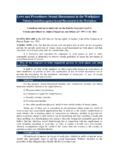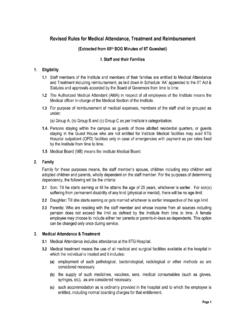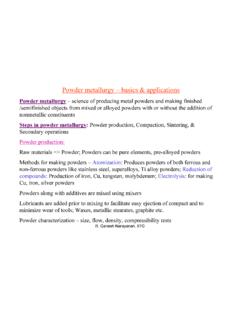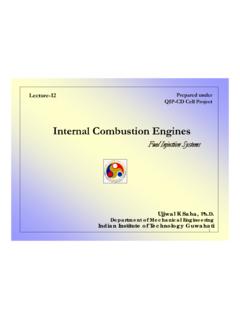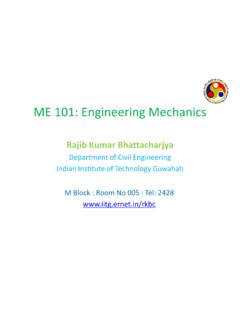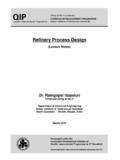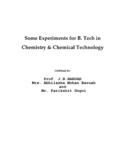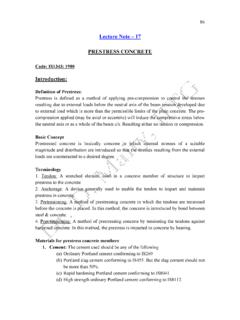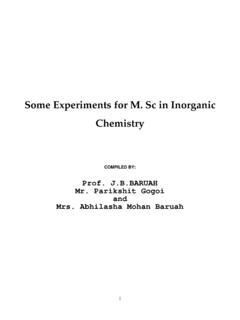Transcription of ANALOG & DIGITAL ELECTRONICS
1 ANALOG & DIGITAL ELECTRONICS . Course No: PH-218. 3-1-0-8. Course Instructor: Dr. Vajpeyi E-mail: Room No: #305. Department of Physics, Indian Institute of Technology Guwahati, India Prerequisite (Nil). Syllabus for ANALOG ELECTRONICS 1. P-N Junctions: Diode theory, forward and reverse-biased junctions, reverse-bias breakdown, load line analysis, diode applications - Limiters, clippers, clampers, voltage multipliers, half wave & full wave rectification, Special purpose diodes - Zener diode, Varactor, light emitting diodes, Laser diodes. 2. Bipolar Junction Transistors (BJT): Transistor fundamentals, transistor configurations, DC operating point, BJT characteristics & parameters, fixed bias, emitter bias with and without emitter resistance, analysis of above circuits and their design, variation of operating point and its stability.
2 3. Field-Effect Transistors (FET): JFET- current-voltage characteristics, effects in real devices, high-frequency and high-speed issues. Syllabus for ANALOG ELECTRONICS (Contd.). 4. Transistors Amplifier: Small Signal BJT amplifiers: AC equivalent circuit, hybrid, re model and their use in amplifier amplifiers, frequency response of basic & compound configuration, Power amplifiers: Class A, B, AB, C and D stages, IC output stages. 5. Feedback & Oscillator Circuits : Effect of positive and negative feedbacks, basic feedback topologies & their properties, Analysis of practical feedback amplifiers, Sinusodial Oscillators (RC, LC and Crystal), Multivibrators, The 555 timer. 6. Operational Amplifiers: Op-Amp Basics, practical Op-Amp circuits, differential and Common mode operation, Inverting & Non Inverting Amplifier, differential and cascade amplifier, Op-Amp applications.
3 Syllabus for DIGITAL ELECTRONICS 7. Number Systems: Decimal, binary, octal, hexadecimal number system and conversion , binary weighted codes, signed numbers, 1s and 2s complement codes, Binary arithmetic 8. Boolean Algebra: Binary logic functions , Boolean laws, truth tables, associative and distributive properties, DeMorgans theorems, realization of switching functions using logic gates 9. Combinational Logic: Switching equations, canonical logic forms, sum of product & product of sums, Karnaugh maps, two, three and four variable Karnaugh maps, simplification of expressions, Quine-McCluskey minimization technique, mixed logic combinational circuits, multiple output functions. 10. Analysis & design of Combinational Logic: Introduction to combinational circuits, code conversions, decoder, encoder, priority encoder, multiplexers as function generators, binary adder, substractor, BCD.
4 Adder, Binary comparator, arithmetic logic units Syllabus for DIGITAL ELECTRONICS (Contd.). 11. Sequential Logic: Sequential circuits, flip-flops, clocked and edge triggered flipflops, timing specifications, asynchronous and synchronous counters, counter design with state equations, Registers , serial in serial out shift registers, tristate registor, timing considerations. 12. Sequential Circuits: State diagrams and tables, transition table, excitation table and equations. Examples using flip-flops. Analysis of simple synchronous sequential circuits, construction of state diagram, counter design. 13. Programmable Logic: Programmable logic devices, programmable read only memory, programmable logic arrays and programmable array logic, Design using PLA, field programmable gate a arrays.
5 14. DIGITAL integrated circuits: Logic levels, propagation delay time, power dissipation fan-out and fan-in, noise margin, logic families and their characteristics TTL, LSTTL CMOS and ECL integrated circuits and their performance comparison, open collector and tristate gates and buffers. Texts: 1. Sedra & , Microelectronics Circuits, Oxford University Press (1997). 2. Malvino, electronic Principles, Tata Mcgraw Hill Publications 3. Robert L. Boylestad & Louis Nashelsky, electronic Devices & Circuit Theory 4. William Kleitz, DIGITAL ELECTRONICS , Prentice Hall International Inc. References: 1. M. S. Tyagi, Introduction to Semiconductor Materials and Devices, John Wiley &. Sons Inc. 2. Michael Shur, Introduction to electronic Devices, John Wiley & Sons Inc.
6 , 2000. 3. R. T. Howe and C. G. Sodini, Microelectronics: An Integrated Approach, Prentice- Hall Inc. 1997. 4. Jacob Millman, and Halkias, electronic devices and circuits , TMH. Publications. 5. Ben G. Streetman, Solid State electronic Devices, PHI, 5th Ed, 2001. Lecture Schedule Room No: 4212. Lectures: Monday: 10:00 -10:55 Hrs Tuesday: 11:00 -11:55 Hrs Friday: 09:00 -09:55 Hrs Tutorial : Hrs Evaluation Strategy Grading will be based on the following: Random Quiz's - 5 (10 marks). Best of three will be counted Informed Quiz - 2 (10 marks each). Mid semester examination (30 marks). End semester examination (40 marks). Minimum 75% attendance compulsory (institutional requirement: your attendance is your responsibility!)
7
